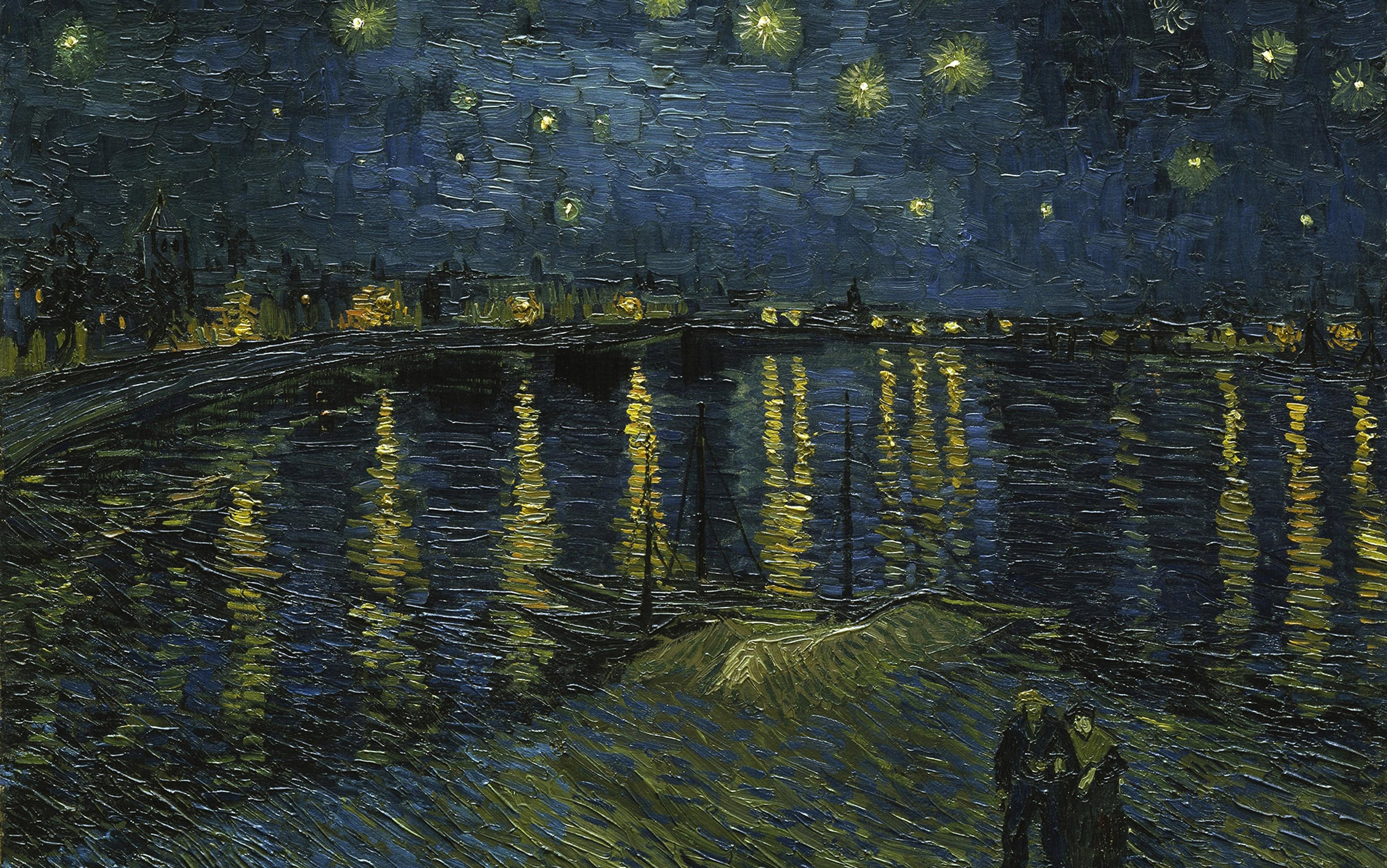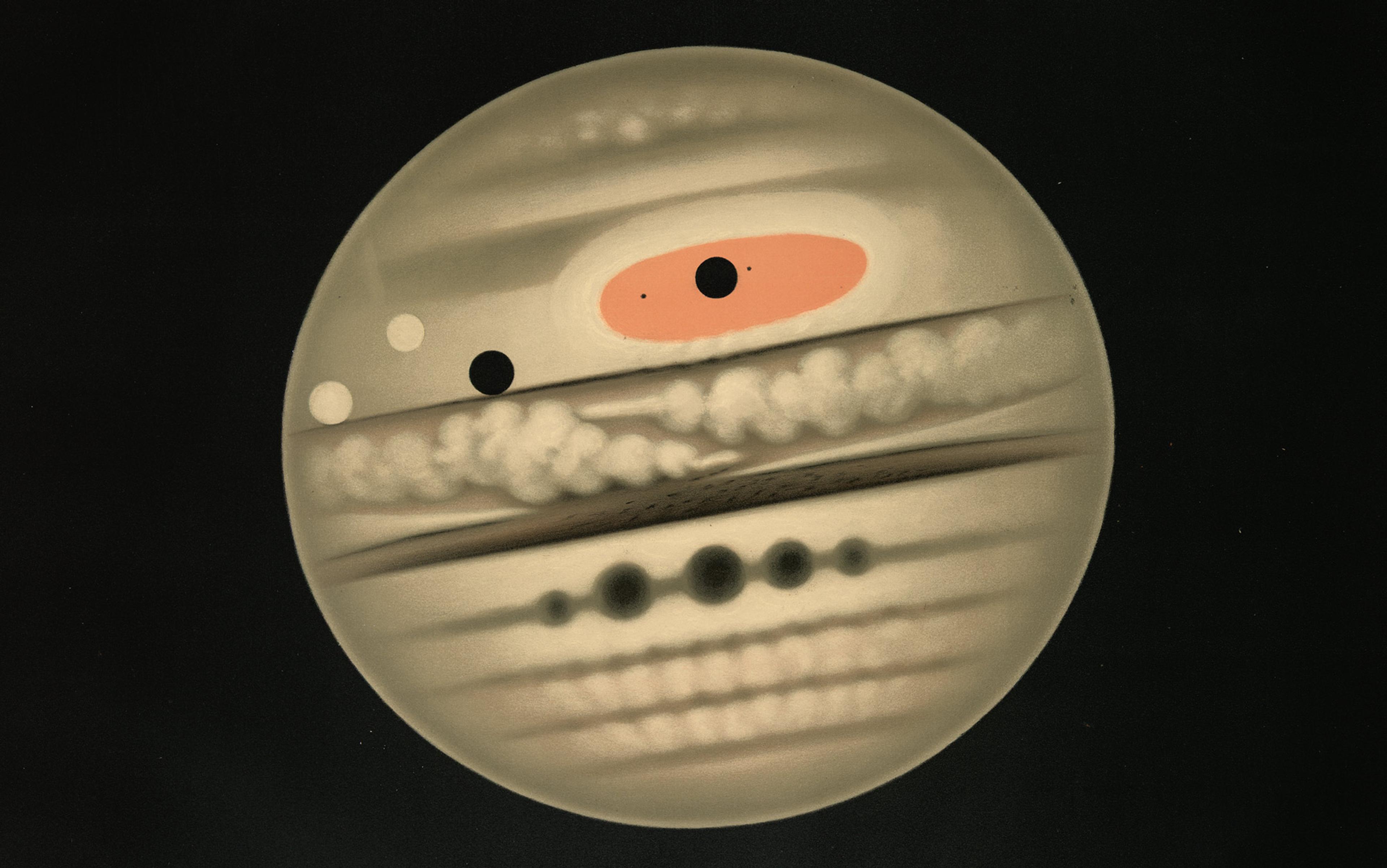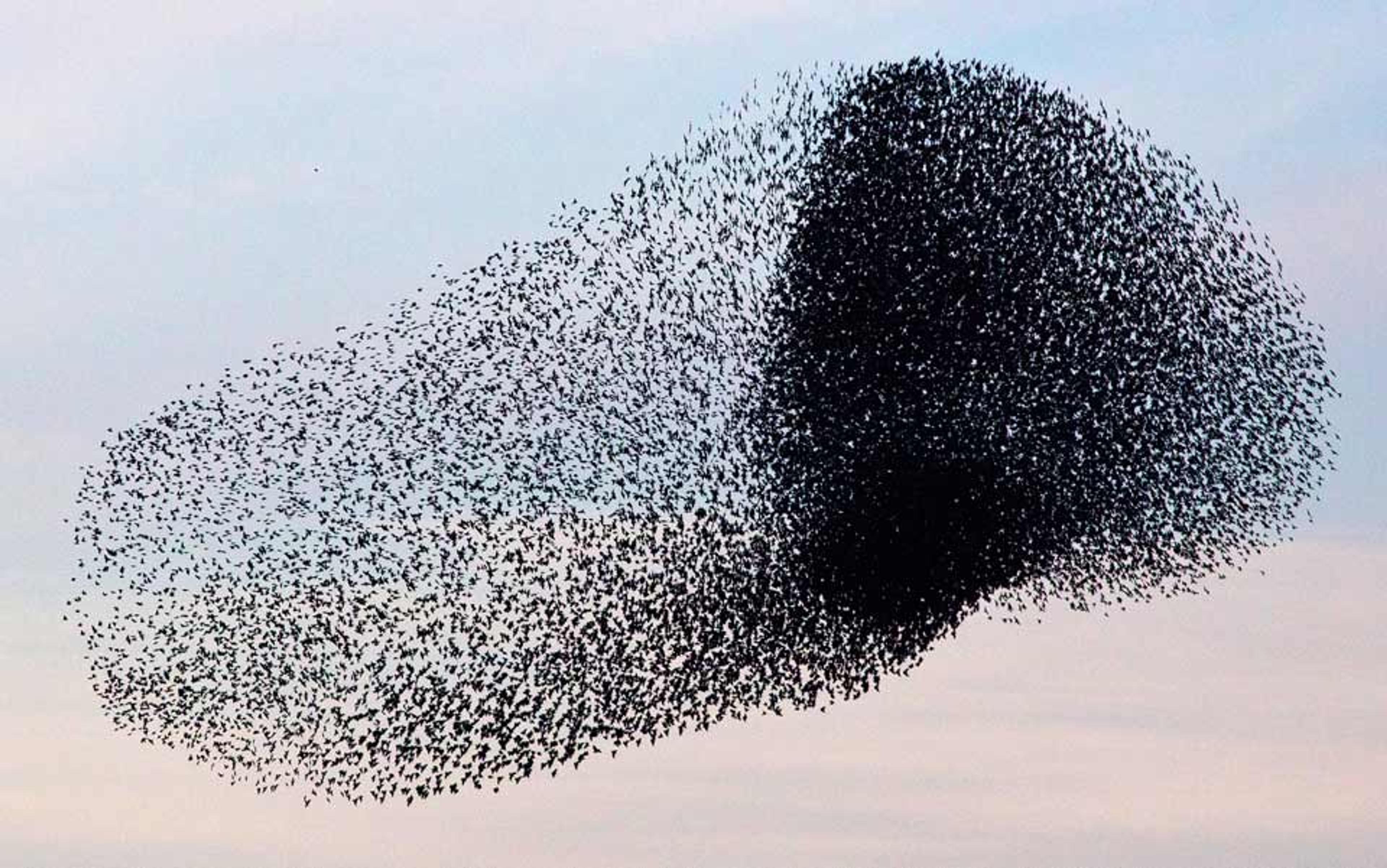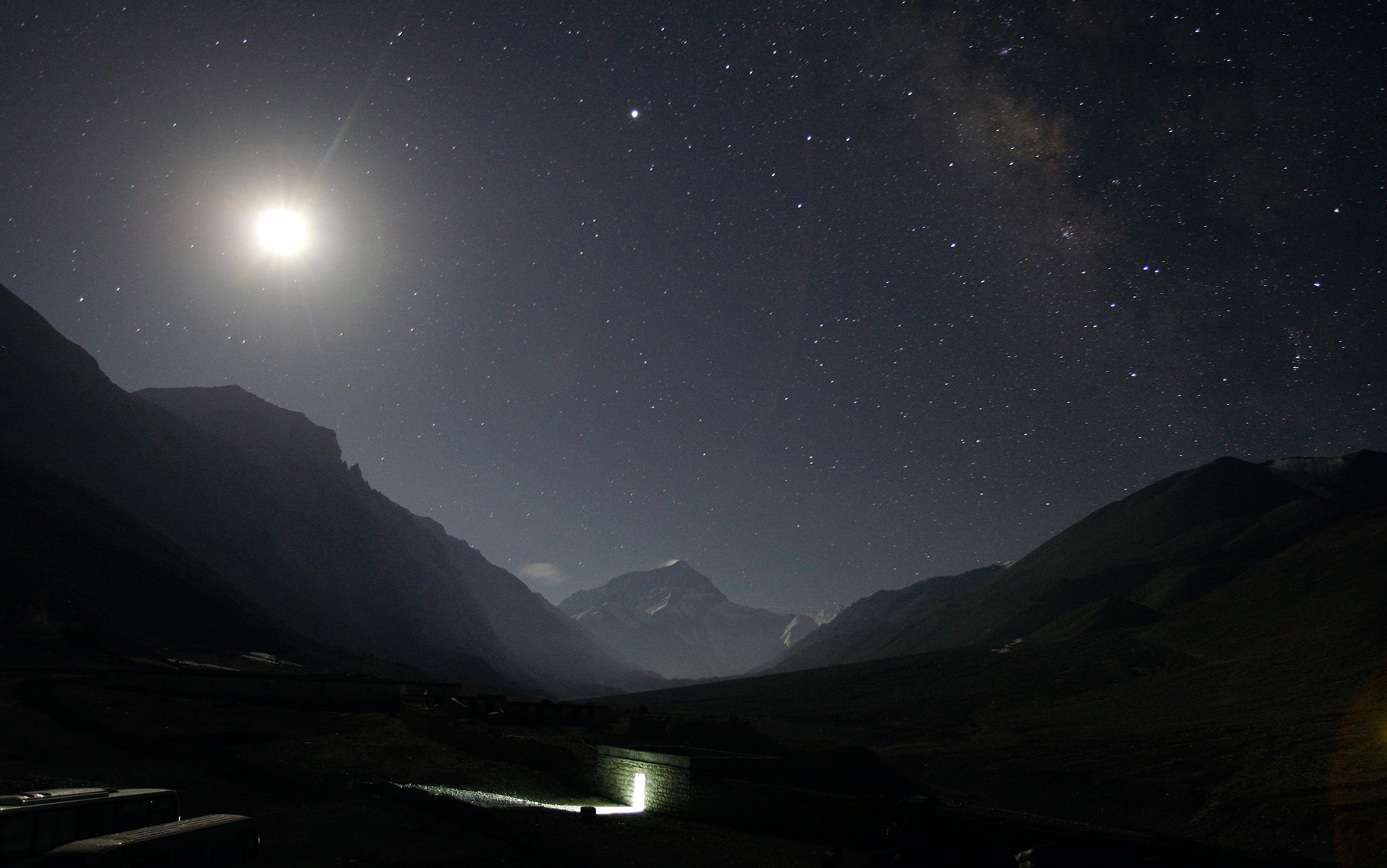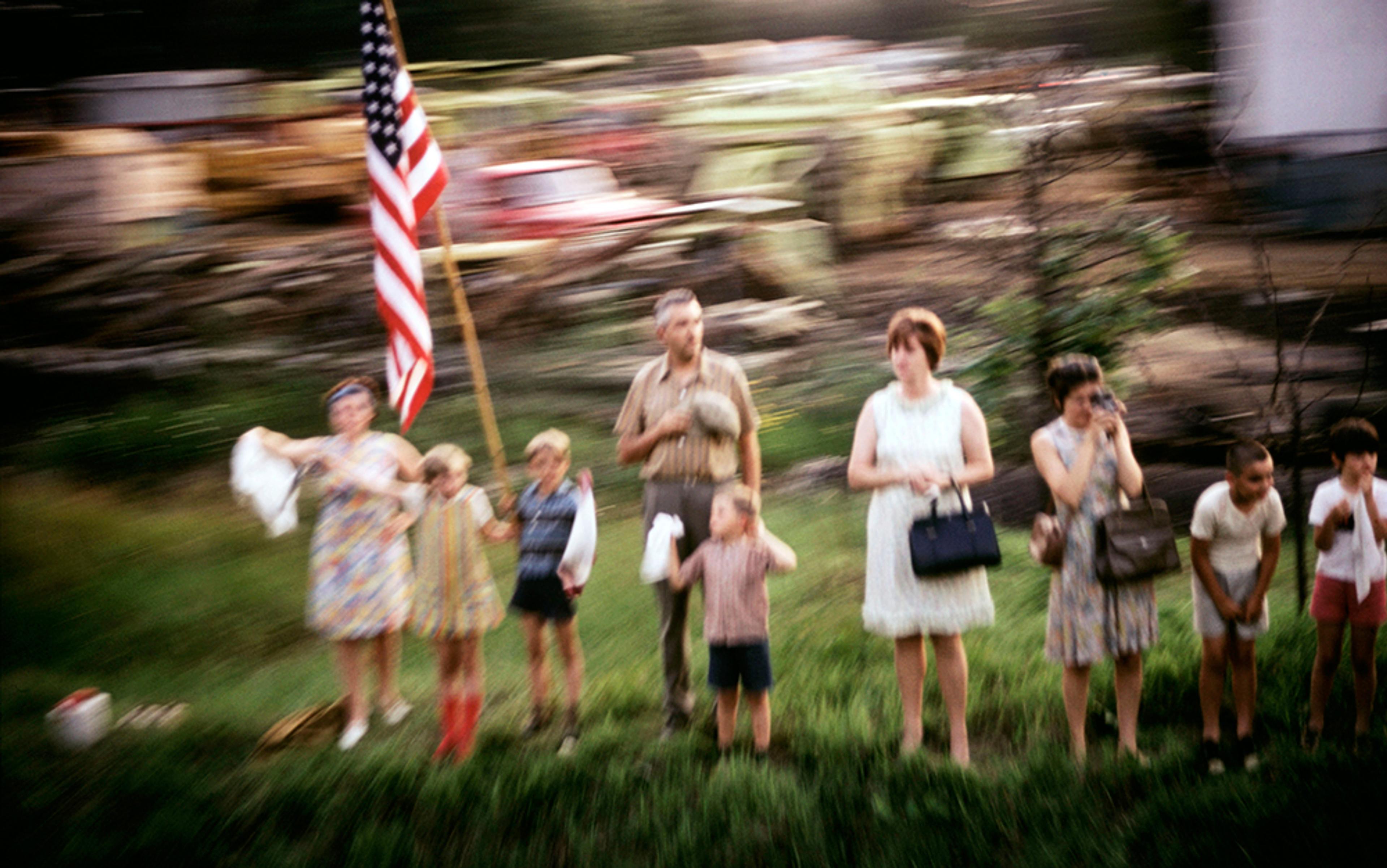The most familiar celestial objects, like Earth, the Moon and the Sun, are spheres. The solar system’s planets have orbits that are roughly circular, and zooming out a hundred-millionfold, the Milky Way is a flattened disk. But zooming out by a further factor of 1,000 from the Milky Way, to encompass our nearest non-satellite galaxy Andromeda, and dozens of others, the shapes look different. The arrangement may look haphazard, but it’s ordered in its own way, in a network of filaments with vast walls and voids between them, called the cosmic web. This structure started forming at the Big Bang, after which slight density variations amplified to a massive scale. It’s still evolving today, with a fractal geometry characterised more by branching flows than orbits.
Despite its astonishing size, the cosmic web is relatable to everyday experience, with surprising connections to similar systems and patterns on Earth, such as the shapes that light makes as it scatters at the base of a swimming pool, or the growth of bubbles. For researchers, such Earth-based analogies can provide a simpler, tangible and even experimentally observable way to understand the Universe’s complex three-dimensional structure.
Other analogies are less scientifically developed, but enlightening in different ways. For example, I am currently working on the idea that the cosmic web evolves via ‘intergalactic rainstorms’, akin to the way rainfall flows into river networks on Earth. There are also other analogous processes that I believe most cosmic web researchers would not dispute. As well as river networks with their branching tributaries, the cosmic web echoes spider webs, transport networks, mycelia, and even respiratory networks and neurons in human bodies. When I contemplate how – and why – the cosmic web’s shape and evolution is echoed down here on Earth, I find meditative and even spiritual value. Even though I have been studying this enormous structure for years, it still evokes awe and curiosity to encounter striking similarities across scales and systems.
In the visualisation below, you can get a sense of what the cosmic web looks like. On the right, we can see galaxies roughly as they might appear in the sky, if the pesky stars in our own galaxy didn’t get in the way and our eyes were more powerful. The middle panel, with yellow nodes (large galaxies) and strand-like green filaments, illustrates how the rest of the matter would appear if it all emitted light. And on the left is a view of how these structures were assembled over billions of years, with tracks of matter flows leading into galaxies and the filaments between them.

From a visualisation of the cosmic web by Miguel A Aragón-Calvo, Julieta Aguilera and Mark SubbaRao/John Hopkins University
The second image, below, zooms in on such tracks projecting in three dimensions, which we call a ‘root system’. It shows the assembly of a large cluster of galaxies in a computer simulation. Just after the Big Bang, the potato-shaped blobs outlined in blue-green are where there was a tiny bit more matter than the surroundings. As gravity drew the matter together, it clumped together. Tracing these paths reveals the bright yellow streaks, the ‘roots’.

Projections of a simulated root system, showing how a galaxy cluster is assembled along tracks. Courtesy Mark Neyrinck
These root systems are also closely related to ‘watershed superclusters’, which are patches of the Universe containing hundreds of thousands of galaxies. Within their borders, matter flows inwards like the tributaries and rivers of a watershed basin. Our home supercluster is Laniakea, which means ‘immense heaven’ in Hawaiian; we are one of scores of thousands of galaxies in it. If the Universe’s expansion weren’t accelerating, Laniakea would eventually become one giant galaxy cluster, with a root system even more intricate than the image above.
While the term cosmic web wouldn’t be coined until the 1990s, researchers began investigating it decades earlier. Arguably, the first was the Soviet physicist Yakov Zel’dovich, who also made major contributions to nuclear physics (including the USSR’s nuclear programme) and fluid mechanics. His paper ‘Gravitational Instability: An Approximate Theory for Large Density Perturbations’ (1970) had only a few modest plots, but contained key insights about the Universe’s large-scale structure. However, it went mostly unappreciated in the West for more than a decade, until the first large galaxy-mapping surveys.
In 1986, researchers at the Center for Astrophysics in Massachusetts plotted the positions of more than 1,000 galaxies and reported a surprise for those in the West. With a paper titled ‘A Slice of the Universe’, they observed that galaxies ‘appear to be on the surfaces of bubble-like structures’, with regions of higher concentrations, and giant, near-empty voids. And it turned out Zel’dovich’s approach elegantly captured these structures’ sharp geometry. At the time, most Western scientists were using techniques that work for gentle undulations in the early Universe, and on even larger scales than the cosmic web, but fail to predict these bubble-like structures.
In 1989, Zel’dovich and his student Sergei Shandarin (who, sadly, died in March 2025, as I was beginning this essay) realised that the formation of the structure’s filaments is mathematically analogous to light’s pattern at the bottom of a swimming pool on a sunny day. In a perfectly still pool on a wind-free day, sunlight refracts at the water’s surface, but there are no patterns at the pool’s base. But with ripples, the light refracts in many directions, resulting in dim patches with less light, and bright patches where light has come from multiple surface locations at the same time. In the cosmos, the pool’s ripples are akin to the density fluctuations after the Big Bang. Without them, matter would have distributed evenly, but instead, in low-density regions, it has spread out, forming a mostly evacuated void, and in high-density regions, it has collided with other matter to form a galaxy.
The growth of cosmic voids obeys some laws governing soap-foam dynamics remarkably well
As recently as 2014, Shandarin and other researchers, including this video’s creator, Johan Hidding, were still using a similar optical analogy in their mathematical models of the Universe’s structure. The short clip below illustrates the process for light nicely, and the result looks similar to the cosmic web.
Another cosmic web analogy with roots in the 1980s is bubbles. In ‘A Slice of the Universe’, bubbles were mentioned mainly to describe the web’s visual appearance. But more recently, researchers have found that bubbles are also relevant to its dynamics, quantitatively.
We are used to thinking of gravity as pulling matter together, but on cosmic-web scales, an arguably more accurate picture is that of voids, which expand like bubbles. These bubbles eventually run into each other; where they do so, matter piles up, and galaxies form.
This bubble analogy is not perfect, of course. Void walls are lumpy, containing galaxies, not smooth like a bubble’s surface. Void networks are also not strictly constrained in their angles, whereas soap-bubble surfaces must join at regular angles, because of pressure equalisation: along a line joining bubble triplets, each bubble must get an equal share of the cross-sectional plane, so bubble surfaces join at 120-degree angles.
However, the growth of cosmic voids obeys some laws governing soap-foam dynamics remarkably well. Just as large soap bubbles in a foam expand at the expense of small ones, which contract and collapse, large voids of the cosmic web expand at the expense of small voids. This is for different reasons: for soap, there is a physical surface tension that the system wants to shed; in the cosmic foam, large voids tend to be the least dense places in the Universe, and accordingly expand the fastest, crushing smaller voids.
In 1996, another analogy emerged – and the cosmic web gained its name – in the paper ‘How Filaments of Galaxies are Woven into the Cosmic Web’ by the astrophysicist J Richard Bond and his colleagues. Textile and web analogies have carried cultural meaning for much of human history, such as with the Fates in ancient Greek mythology, who spun and wove cosmic destinies. The term cosmic web resonated, helping to carve out a topic of study distinct from Universe-wide cosmology on larger scales, and galaxy formation on smaller ones. Like ‘bubble’, the word ‘web’ gives more than descriptive insight.
As I have found in my research, partly inspired by the artist Tomás Saraceno’s installations of spiderwebs, the cosmic web is a good approximation of a structural ‘spiderweb’, as used in structural engineering: a collection of nodes linked by cords that could all be in tension.
Geometry is a universal language, so it is not surprising that the same geometries arise in different settings
This ‘cosmic spiderwebs’ finding came through a curious route. In 2011, the physicist and origami designer Robert Lang found that a type of origami called a tessellation (a collection of polygons with pleats between them that can be folded and then pressed flat) has equivalent geometry to a spiderweb. I remembered that it was possible to use the same geometric tools, which describe these polygons expanding or contracting, to model the cosmic web.
This geometric toolset, called graphical statics, was developed in the late 19th century by, among others, the major physicist James Clerk Maxwell. It was used to design great structures such as the Eiffel Tower. Geometry is a universal language, so it is not surprising that the same geometries arise in different settings, even if for different reasons.
The analogies I’ve described are established, but there are others that are still works in progress, with aspects that could eventually be falsified. These analogies are interdisciplinary, which sometimes can be an awkward fit in science. But I find exploring them rewarding: they readily engage curiosity and awe, and have the capacity to deepen understanding of each discipline they touch.
The first is an analogy I am particularly intrigued by in my own work: the flow of rivers.
For cosmic web researchers, it’s well known that water flows downhill into rivers, similarly to how matter flows down ‘hills’ in the gravitational potential into filaments and galaxies. This analogy has inspired definitions of superclusters and voids. But recently, I have been looking at it more rigorously with the undergraduate student Glimpse Pandey at Queens University of Charlotte in North Carolina.
I remember having great fun as a child, moving sand around in the rain at a playground, making and diverting little rivers. I still like to play with ‘stream tables’, pouring water through sand to produce tabletop river networks. Last year, for a course I taught, I may have been the first to use a stream table (borrowed from the geography department) in an astronomy lab.
Water carves almost all landscapes. And the branching dendritic (treelike) patterns it makes are all over the globe. Those created by the Yarlung Tsangpo river basin in Tibet, depicted below, are particularly remarkable.

Yarlung Tsangpo river basin in Tibet. Courtesy JPL/NASA
The analogy between river basins and the cosmic web is far from perfect, but both are systems that enable transport and concentration of matter from an originally near-uniform arrangement. In the terrestrial case, water or snow is deposited somewhat evenly on a landscape, but being in rivers allows it to move faster. In the cosmic case, matter also originates almost uniformly, and ends up clumping and flowing. Although this is not proven, it may be that, when gravity forms filaments along the way into a galaxy, it increases the matter flow like a river.
Flowing matter carves grooves into the gravitational potential, like water might on a rubber sheet
We are currently studying the relationship between the cosmic web and river networks via an ‘intergalactic rainstorm’. In the usual cosmological model, matter forms the cosmic web ponderously and steadily over the course of cosmic time. But what if a ‘rainstorm’ happened, dumping a lot of matter onto the cosmic web at once? Would filaments swell with matter, like rivers do with water after a rainstorm? We do not realistically think this happened in our Universe, but investigating it both clarifies the extent of the link to terrestrial hydrology, and stress-tests our understanding of the cosmic web in exotic scenarios of the expansion history of the Universe.
To produce a rainstorm in a computer simulation, we introduce a pause in the Universe’s expansion: a brief period of cosmic history with a dramatically slowed expansion rate. In the usual case, matter falling onto a filament has to chase it as cosmic expansion pulls it away. But when the expansion is halted, it’s like a parade whose leader suddenly stops: matter piles up. We do find that the filaments swell up by a barely perceptible amount. Surprisingly for me, galaxies enlarge even more than the filaments if there has been a rainstorm, and this persists for quite a while.
Besides this small ‘flooding’ effect, which enlarges filaments and galaxies, the main effect of a rainstorm is that it suddenly produces a great deal of cosmic structure development at once, advancing the structure to what it otherwise would have been far in the future. Erosion is the terrestrial hydrological analogy to this advancement in structure. On Earth, water flows carve channels into the land. In the celestial case, flowing matter carves grooves (filaments) into the gravitational potential, like water might on a rubber sheet.
Celestial and terrestrial river networks have similarities and differences in their predictability, too. We think the locations of the filaments of the cosmic web are essentially predictable from matter’s arrangement after the Big Bang. Similarly, locations of rivers that get carved into a steep-enough initial landscape can be predicted accurately. But for rivers on flat landscapes, small random perturbations can grow, giving a meandering river with shifting curves, unpredictable from the initial landscape after enough time has passed.
At smaller scales, happenings within the cosmic web, in galaxies and filaments, may be entirely unpredictable from the early Universe. (Would this essay have been predictable, even in principle, billions of years ago?) Similarly, the detailed, turbulent flows in a terrestrial river are unpredictable from an initial landscape.
In sum, interesting things happen where flows converge, both in the cosmos and on Earth.
Many other flows happen on Earth, some of them caused by humans, and they also visually resemble branching structures. For example, the map below shows truck traffic to, from and within Illinois, with widths proportional to the amount of traffic. Amusingly, in this way, a big city like Chicago is more of a ‘heartland’ than a rural location is.

Flows of trucks going to, from and within Illinois, 2017. Courtesy the US Department of Transportation
For nationwide transportation, it is most efficient to have just a few high-capacity roads, rather than a low-volume street grid like Manhattan or even a whole country covered with a drivable surface. The road network pulls resources efficiently from a nearly uniform arrangement into (and out of) cities, just as the cosmic web pulls matter that was once uniformly distributed efficiently into galaxies.
Networks on a landscape also interact with each other. A reason why Chicago grew to be such a major hub is that it forms a short, flat bridge spanning the divide between the Mississippi and Great Lakes-St Lawrence watersheds, offering the easiest route between the Great Lakes and the Mississippi River transportation networks. That is, a continental divide runs through Chicago, even though it is far flatter than the dramatic one in Colorado, the Rocky Mountains.
Fungal mycelial networks are another example of branching reminiscent of the cosmic web. They sustain themselves, and also carry nutrients such as carbon among plants. Just as in these other systems, their branching optimises the flow, allowing it access to a large area. Multidirectional flows were recently observed in mycelial networks, but these are unlike flows through the cosmic web, which, like a river, are essentially one-way. The television show Star Trek: Discovery (2017-) featured a mycelial network that the starship used to traverse great distances within the Milky Way. It’s interesting that the real cosmic web bears some similarities to mycelium. However, if the cosmic web could somehow provide transport, its network would be best for shortcuts between galaxies, rather than trips inside them. The cosmic web would offer less-speculative advantages for intergalactic transport, too: if hydrogen fuel needed to be collected along the way, it is already conveniently most prevalent in filaments between galaxies.
I encouraged Physarum to connect the nearest several galaxies in an arrangement called the Local Sheet
The Physarum polycephalum slime mould, neither plant nor fungus, also exhibits remarkable network structures in its plasmodium life stage. If oat flakes are placed on an arrangement of nodes, a nearby slime mould will generally connect them to form an efficient network; for example, it came up with a close approximation of the Tokyo subway system. This has inspired an algorithm to infer filament locations from observed galaxy locations.
Below appears an image that I call ‘Four Cosmouldogists’: superimposed are four relatively successful attempts I made to encourage Physarum to connect the nearest several galaxies in a (conveniently flat) arrangement called the Local Sheet. The attempts are shown in yellow (Physarum’s actual colour), pink, blue and black. The Milky Way is in the centre; Andromeda, the nearest large galaxy to us, is just below; and the many others near the edge are called the Council of Giants. It was fascinating to sample the slime moulds’ opinions on the matter (filaments in the Local Sheet); I was surprised at how varied their routes were, which I have not seen emphasised in other work about slime moulds’ efforts. It shows nicely how science is sure about some things (the existence and positions of these galaxies), while taking a good guess about other things (the filament locations), which exist in a middle ground between knowing and not-knowing.

The routes of four slime moulds between the locations of galaxies of the Local Sheet. Supplied by the author
The cosmic web also has similarities to systems within our bodies. A cosmic web analogy could not get more visceral than that.
Breathing is so familiar that most people don’t notice it unless either meditating or having respiratory problems. But even breath-conscious people seldom appreciate the magnificent structure of the lungs. In the bronchial tree, the tubing branches an amazing 23 times from the trachea down to the alveoli where air exchange with the blood happens. This branching allows a huge surface area, about half that of a tennis court, to fit in your chest.
Cosmic web connectivity around a cluster obeys similar rules to neuron dendrite geometries
As you breathe in, imagine an oxygen molecule landing somewhere in your lungs, somewhere random on that surface, and entering your bloodstream. It gets repeatedly funnelled back through another vascular branching structure into your heart. Then blood flows out of the heart, repeatedly branching again, through arteries, where the oxygen gets used somewhere in your body. Finally, the blood is pulled back through a final branching structure of veins, to circulate again. Organisms as complicated and large as we are would never have come to be without the efficiency this geometry allows. Yet again, as with the cosmic web, we have branching networks enabling efficient flow from a uniform arrangement to a node.

A bronchogram demonstrating the divisions of the airway tree. Courtesy P A de Jong et al, ERS/2006
Neurons, which you’re using to parse these very words, also exhibit dendritic geometries; they’re the smallest structures I’ll discuss. Individual neuron dendrite geometries come from a balance of a few factors: cell material conservation, communication speed, and availability to form synapses with a wide range of other neurons. Interestingly, our preliminary findings show that cosmic web connectivity around a cluster obeys similar rules, but for reasons we do not yet understand. On the other hand, large collections of neurons, such as the brain, have some substantial differences from the cosmic web: many neurons are connected to other neurons far across the brain, whereas the cosmic web connects only nearby structures, and in a bubble-foam-like formation that does not obviously relate to groups of connected neurons.

Left image (A): mouse hippocampal neuron showing central body (green) and synaptic connections (yellow). Courtesy Lisa Boulanger. Right image (B): visualisation of the cosmic web. Courtesy Springel et al, 2005/Max Planck Institute
This has been just a brief survey of webs and flows that echo the cosmic web; there are many more. Some that I am studying, relevant to climate-crisis mitigation, are fracture networks left in rocks by oil and gas exploration, which could usefully carry heat and carbon for geothermal energy and carbon capture. Groundwater flows, too, are important to understand in our changing climate.
I’ve found the contemplation of similar flows over a vast range of scales, including within my body, to provoke awe, and to have great meditative and even quasi-spiritual value, in trying times. This might be called the ‘pansystemic’ (all systems) or ‘panscalar’ (all size scales) effect. This references what the author Frank White called the ‘overview effect’, the shift in perspective that astronauts describe, and the ‘panzoic’ (all life) effect, the experience of imagining life throughout the Universe, coined by my colleague the astrobiologist Graham Lau.
Recently, I came across the artwork below by the photographer Jan Kriwol and the digital designer Markos Kay that captures this feeling for me. It shows the human circulatory system gazing at red roads and blue rivers, some of Earth’s circulatory systems. The person might just be reading a map, but I imagine a contemplation of metaphorical music. Whereas the ancient Greeks admired the harmonic ratios of the celestial spheres, here I see humanity appreciating the music of the networks between and within the spheres; reflecting upon patterns that reach down into the body, and up to the largest scales we can imagine.

Mountains (2017) by Jan Kriwol and Markos Kay, from the series ‘Human After All’. © Markos Kay & Jan Kriwol
This Essay was made possible through the support of a grant to Aeon Media from the John Templeton Foundation. The opinions expressed in this publication are those of the author and do not necessarily reflect the views of the Foundation. Funders to Aeon Media are not involved in editorial decision-making.

